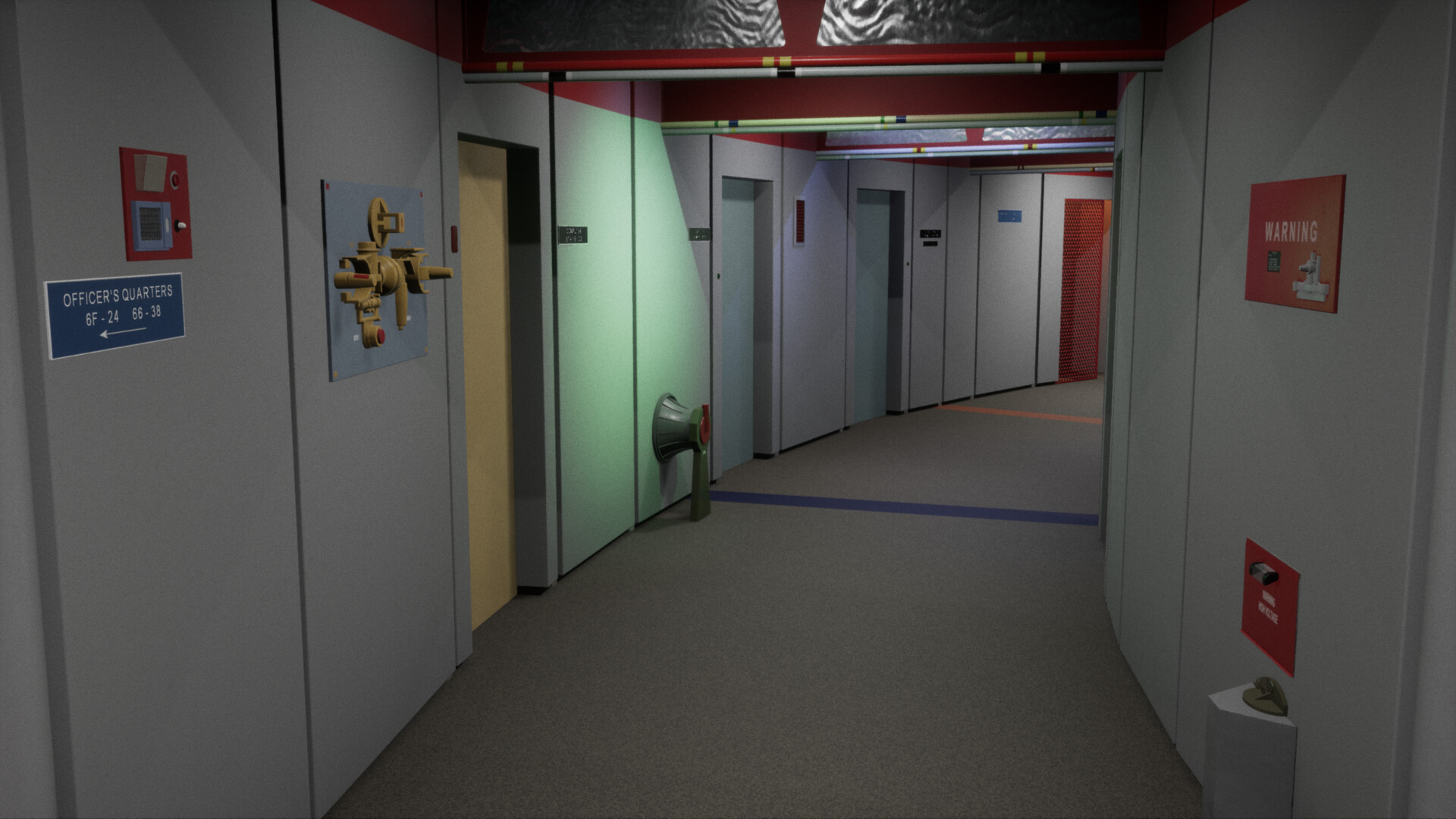- The way I would have reimagined the Enterprise for Strange New Worlds;
- Five rules for reading the news, from Big Think, and my thoughts about them;
- Apocalyptic rhetoric from the right; conspiracy theories about the Maui wildfires.

I’ve enjoyed the current season of Star Trek: Strange New Worlds well enough. (Though I’m extremely irritated by its not displaying the episode titles.) But it’s always bothered me about this franchise, extending from 1966 to the present day, that the producers and production designers keep re-imagining and changing everything when there’s no particular reason for doing so. (Never mind the early movies’ penchant for destroying the Enterprise again and again, so they kept having to get new ones.) The ship of course, and also the uniforms.
If I were making a Star Trek series set on the same Enterprise that James Kirk captained, but a decade or two before when Captain Pike commanded it, this is what I would do.
I would use exactly the same exterior ship as TOS, and exactly the same interior sets. Or, maybe the interior sets with some small alterations to make them look just a bit more primitive than we saw them in TOS. At first.
Then, film episodes of this new show on these sets… but at every opportunity, go around corners to see areas we never saw in TOS, on matching sets. Expand the sets, show us more of the ship. Show the backside of the sickbay, and of the transporter room. Show the toilet cubicle on the bridge, and show the bathrooms in the crew quarters. Show us exactly how many science labs there were, and where they are. Do a steadicam walkthrough from, say, the Bridge to Sickbay, and especially to Engineering, and establish once and for all where these rooms were relative to each other. (Is Engineering at the back end of the saucer, or in the lower hull?)
Show us more and more of the ship, in the old TOS style. Show that, on the widest decks in the middle of the saucer, the corridors are more sharply arced toward the center, more gently curved toward the outside. And so on.
This could have been a lot of fun. Oh, and every once in a while, show one of those primitive features being upgraded to the actual ones we saw in the TOS. Give the impression of continuous improvement. Show that Pike struggled with issues Kirk took for granted.
Today’s food for thought.

Big Think, Kevin Dickinson, 16 Aug 2023: 5 rules for how to read the news — the Big Think way, subtitled “We can no longer approach the news as passive consumers.”
The takeaways, in Big Think’s format:
• Today’s news cycle often aims to heighten emotions and urgency to keep consumers engaged longer. • But that strategy combined with the firehose of content can make the news cycle stressful and emotionally draining. • Strategic thinking can help us approach the news with specific (and healthy) goals in mind.
Here are the article’s five rules.
#1. Ask strategic questions
I don’t know that I do this when browsing the web or thumbing through the newspapers, because I cover a lot of sources every day, and I’ve learned how to skim, but I certainly do it when reading books. (E.g., my “questions going in”.)
#2. Avoid sports-like coverage
Meaning items like who’s ahead in the polls, as opposed to what the actual issues are. I’m well aware of this, as well as the tendency toward “false-equivalence,” where “both sides” must be reported on as if there are only two sides and their arguments have equal merit. Thus, currently, claims by Trump’s supporters that the charges against him violate his first amendment rights, whereas it’s been established over and over, even in the words of the latest indictment, that the charges are *not* about those right. The news (I’m thinking TV network news) keeps repeating these Republican talking points anyway, lest they be accused of partisanship, rather than trying to clarify facts.
#3. Look for macro patterns
Yes, I’m very aware of this, the way the news media, by its very nature (not because they’re being duplicitous), prioritize bad things (those are the things that are news!) that happen and so give people the impression that the world is a terrible place. The point of the news is they’re reporting the *exceptional* news. I’ll quote from the article.
Another way the news keeps us engaged is by reporting on the surprising, interesting, and threatening. After all, if it were the same old, same old, then it wouldn’t be news. However, because of how our minds prioritize negative information, our view of reality can be distorted if we conclude that one-off incidents are representative of macro trends.
Take airplane crashes. Many people fear flying because they can vividly recall frequent reporting of such incidents. But crashes are as rare as they are dramatic. The macro reality is that commercial flight is incredibly safe. Today, the annual global death rate is one death per 7.9 million passengers (compared to 170 deaths per million drivers in the U.S. alone).
The same is true for a host of other popular news topics. Frivolous lawsuits? Not as common as you would think. Shark attacks? Don’t give in to the Discovery Channel hype. Violent crime? While there has been an uptick during and after the COVID pandemic, it thankfully remains below historic norms.
Aside from the news media, conservatives seem to deliberately exaggerate issues like these to scare their base into voting Republican. (The way the keep insisting the centers of big cities are lawless hellholes. Which of course is not remotely true.)
#4. Suss out root causes and proximate outcomes
This is the idea that anything bad that happens is the fault of the current president, or governor, or mayor. This is almost never the case.
#5. Expand your worldview
This means looking at multiple news sources, and I do that to an extent — though not to the extent of looking at Fox News (or OAN or any of the other far right sites, simply on the grounds that they claim so many things that are flatly not true, playing to an ignorant, paranoid base). I do appreciate the page in the print magazine The Week that samples “views from abroad,” and my Google News Feed is adjusted to show me pieces from BBC, the British papers, even Le Monde and some others.
\\\
Resuming our regular programming.
Washington Post, Paul Waldman, 16 Aug 2023: Opinion | Apocalyptic rhetoric is just as dangerous as the violent kind
What fascinates me are the repeated Republican injunctions that the Democrats and liberals and progressives — whose basic program, it seems to me, is to improve life for everyone, even at the expense of challenging verities and privileges of the white Christians who have for so long presumed their right to rule over the entire country — are deliberately seeking to “destroy our country.” What do they mean by that?
Barely a day goes by without prominent Republicans repeating that claim. Trump regularly says his political opponents will “destroy the country,” or have already nearly destroyed it. It’s a staple of Florida Gov. Ron DeSantis’s rhetoric. “If woke ideology takes over, it will destroy this country,” DeSantis says. If President Biden is reelected, the governor insists, “the left is gonna absolutely destroy this country.”
Waldman makes the point that they’ve been saying this for decades…
Rhetorical excess is nothing new, and can be found in both parties, if not always in the same form. But the hardening of the idea on the right that if a Democrat reached the White House he must be carrying out a scheme to bring about America’s end happened with the election of Barack Obama. Republicans might have loathed Bill Clinton with a burning fire, but even if they thought he was so corrupt that he would murder his enemies, they didn’t think he had a secret plan to destroy the country in such a way it would literally cease to exist.
That was, however, precisely what they said about Obama. Most of the rank-and-file believed he was a foreigner, and even many who accepted that he was born in Hawaii claimed he was carrying out a nefarious plan to bring the country to its knees. Even at the end of his presidency, when it was undeniably clear that he was an ordinary center-left Democrat, Rubio could insist during a 2016 primary debate that “all this damage that he’s done to America is deliberate.”
What damage?? They never seem to spell this out. What was worse in America after Obama’s presidency? “[H]e was an ordinary center-left Democrat.” Waldman ends:
Any rational Republican knows the truth about the next election: If Biden wins, it will mean nothing more than four years of policies they don’t like. That will be deeply unpleasant for them. But it won’t mean the end of America, and they shouldn’t be allowed to say so without challenge.
We ought to treat apocalyptic rhetoric just like we treat violent rhetoric: Take note of it, condemn it, challenge candidates to defend it, and explain the threat it poses. Why? Because many of the voters who are listening think the Republicans spinning out wild tales of America’s imminent destruction mean what they say.
\\\
Finally, anytime something out of the ordinary happens, especially a catastrophe like the fires in Maui, there are people of a certain mindset — which I can’t help observing, correlates with anti-science, anti-gay, even racist rhetoric — who feel certain it must have been *done by someone*.
Ars Technica, 15 Aug 2023: Maui truthers are so dumb they’re using a Falcon 9 photo as wildfire evidence, subtitled “You can always count on conspiracy theorists to make a tragedy worse.”
The Quint, 16 Aug 2023: Old, Unrelated Images Shared to Claim ‘Lasers’ Were Behind Wildfires in Hawaii, subtitled “Both images are from 2018; one from the Falcon 9 Space X launch, and second of a fallen meteor from Michigan”
PolitiFact, 15 Aug 2023: “Wildfires do not completely burn out cars, glass and all, yet leaving nearby trees and utility poles still standing upright.”
Rating: False.
If Your Time is short
- It is common for trees, utility poles and more isolated features to remain standing even after wildfires destroy other structures in the same area, wildfire experts told PolitiFact.
- Wildfires that spread in areas where structures and other human developments meet wildlands and vegetation are often spread by flying embers, also known as firebrands, experts said. Those embers can blow past trees or poles, but larger structures that allow the accumulation of those embers are more vulnerable.
- Experts said the fire damage in Hawaii looked like standard wildfire damage, similar to what has been seen in the past.
This last item strikes me as simply an error of intuition. Similar to the idea that a jet aircraft plowing into the ground at full speed must leave some visible wreckage. But the one that hit the Pentagon on 9/11 didn’t; and as confirmation, the one that nose-dived into the ground in Japan didn’t. They only left craters.






